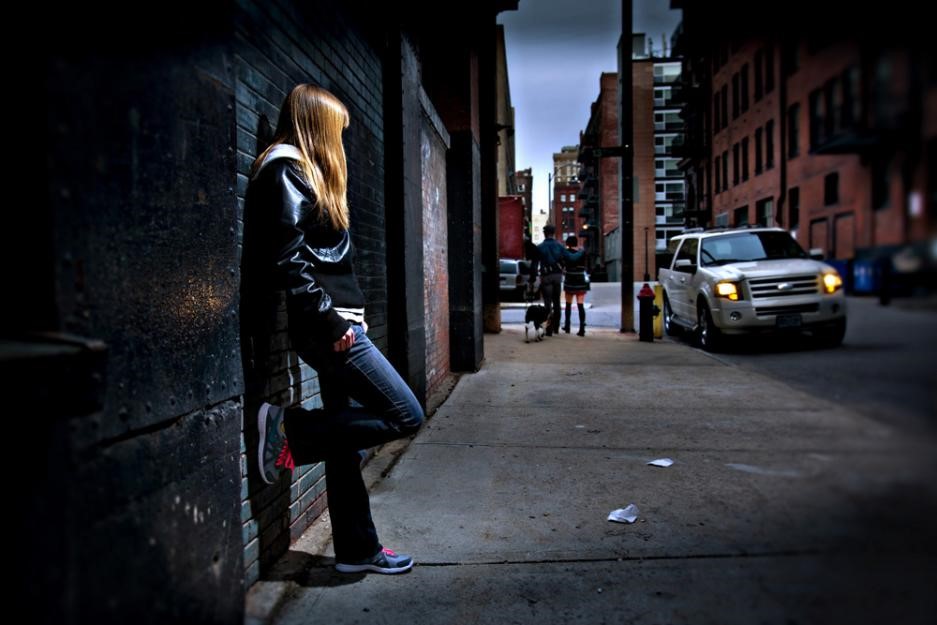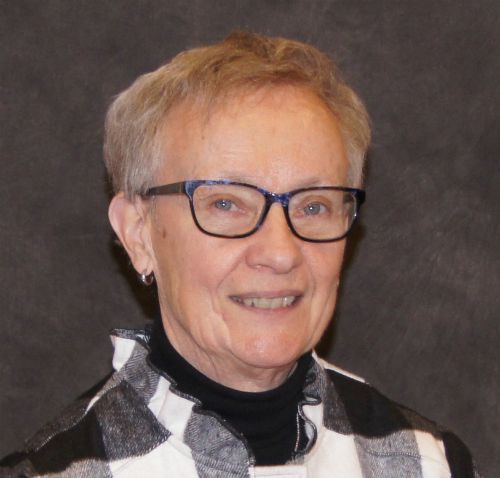Take time to reflect on the image of the young woman. Though posed, it reflects a harsh reality for trafficking victims on streets across the United States and around the world.
- What do you think is going through her mind as she stands there?
- Who else is watching her? What might they be thinking?
- What would you do if you encountered her in real life?

This photo illustration of a young woman depicts the effects of human trafficking. (CNS / Lisa Johnston, St. Louis Review)
People become aware of human trafficking in different ways. Some aren't aware of it until they are trapped in it. Others learn of it through random encounters with victims or survivors.
- What exposure have you had?
- Could this story make a difference in your life or in the life of someone you know?
Trafficking calls for action from us all
When I first met women who had survived sex trafficking and were moving into recovery, I was awed by their strength, courage and resilience. How could anyone survive what they had experienced and still have hope? One told me, "God reached into hell and pulled me out."
I wanted to say, "Yes, but give yourself credit." She now operates a nonprofit that helps other victims and survivors. Another told me her buyer left her for dead in a motel. She has since earned an associate's degree in nursing and landed a job.
How did I meet them? At the time, I was responsible for Catholic Campaign for Human Development grants, and a pastor asked if the nonprofit mentioned earlier would qualify for a grant. It earned funding for three years, the maximum CCHD allows. I became a board member for the nonprofit, assisting them for five years and helping them get other grants.
When younger, these women were among those at great risk — runaway youth. The National Conference of State Legislatures cites studies showing that:
- youth age 12 to 17 are more at risk of homelessness than adults
- one in seven young people between the ages of 10 and 18 will run away
- 75 percent of runaways are female.
If runaways or homeless youth are on the streets without a safe place to go, their abduction is likely within 48 hours, according to public safety officials. They often run from or are forced out of terrible home situations. Many believe nothing could be worse. Unfortunately, they are usually wrong.
I was frustrated to know my home state, Missouri, is lagging behind in protections for child sex trafficking victims. According to Shared Hope International's Seeking Justice 2018 Report, only 23 states and the District of Columbia prohibit the criminalization of minors for prostitution offenses by adopting varying statutory approaches. Missouri is not among them. The report notes that child sex trafficking victims may still endure arrest, detention, interrogation and/or adversarial investigative practices that further victimize them. While better than nothing, as the report states, not all protective laws "are necessarily safe for all exploited youth."
States may be failing exploited children and adults. However, local nonprofits, organizations, agencies, education and health care facilities and systems, faith communities, anti-trafficking advocates and law enforcement are working together to address human trafficking. One example here in Missouri is a county health department whose director established a task force consisting of representatives from all these sectors. Its primary goal is prevention through education, intervention and collaboration. I am on this task force and I learn every time I participate. I also contribute from my expertise, which comes from more than 18 years of experience fighting human trafficking. I am grateful for the colleagues who share my passion to end this tragedy.
Focus on education
While not downplaying the importance of serving victims and survivors and working for legislative changes, I focus primarily on education. One key element in education is serious discussions with parents, grandparents, guardians and youth about the dangers of social media. Youth often unknowingly put themselves at risk for exploitation by what they post on social media.
A police officer, sheriff and district attorney on the county task force talked about how predators prowl social media platforms and apps, looking for attractive young individuals' photos and information to use in their ads and promotional information. They are selling a lie, but the innocent are publicly exposed. Predators may also engage in sextortion, the practice of extorting money or sexual favors from someone by threatening to reveal evidence of their sexual activity.
Predators identify the most vulnerable youth, marginalized in some way, lacking self-esteem and/or self-confidence. These young victims live in your city, maybe even in your neighborhood. You may have seen one of them in your hospital's emergency room or at the truck stop on the interstate. They may even be a student in your high school or university.
I am stupefied by how many adults allow their children unrestricted or unmonitored use of the internet and social media. It is good that more adults are enforcing rules about their children's use of technology and limiting access to the internet and social media.
Education allows prevention and intervention. It teaches about risk factors like viewing pornography, exchanging or sending online messages or photos with sexual content, meeting secretly with online acquaintances, exchanging sexual acts for money or participating in unhealthy relationships.
Children as young as primary students unintentionally advertise their vulnerability by what they post on social media. As I have learned, the most vulnerable include runaways, foster children, immigrant youth, LGBTQ youth, those thrown out of their own homes and those living in poverty or in dysfunctional families. Sadly, predators know this and seek them out.
Predators also make advances on children at malls, restaurants, coffee shops, arcades, movie theaters and other places where youth gather. Explaining to youth what human trafficking is, how they and their friends are at risk, and what they can do to avoid being targeted, lured or chosen as victims can help them understand how to protect themselves and their friends.
While speaking to one university class, I explained to students how they might be approached while hanging with friends at the mall, who might be targeted in their group, and how best to respond. A young woman quietly raised her hand and said, "That happened to me." When I asked how she responded, she grinned and said, "Sister, I won't tell you what I said to him!" Her classmates laughed, but she drove my point home, loudly and clearly.
Sadly, many victims are much younger than college students. In the vicious human trafficking world, the younger the victim, the more they earn for their trafficker. In many cases, predators use violence and drugs to control victims; for these victims, recovery entails getting and staying sober, in addition to healing from physical and emotional trauma.
Broader concerns
So far, we have considered children/youth, but the plight of trafficked adult women and men is horrific too. The trauma of every human trafficking victim is life-altering. It requires long and intense therapy to heal and recover. We celebrate every recovery and mourn every unsuccessful effort.
Human trafficking is a complex tragedy that dovetails with many other social justice issues. Whenever and wherever people are at risk, they are vulnerable to trafficking. They may be victims of natural disasters, detainment at the U.S. border, coyote abandonment, gun violence or terrorist attacks. They may be laborers in fields or factories.
When you see a person you suspect is being trafficked, respond with compassion, being careful not to put him or her at risk. You can call the National Trafficking Hotline at 1-888-373-7888. They will give you safe, accurate information. If it is an emergency, call local law enforcement; many officers are trained to respond.
Whatever you do, don't look away or remain silent! I have not! And I teach students: "See something, say something."
Visit the excellent website of the U.S. Catholic Sisters Against Human Trafficking — a faith-based national network that offers education, supports access to survivor services and engages in advocacy to eradicate modern-day slavery.
Learn about the Polaris Project, which operates the national human trafficking hotline and is a leader in the global fight to eradicate modern slavery. It focuses on freeing survivors, preventing victimization and using data and technology to pursue traffickers.
Sr. Christensen fights human trafficking alongside people who have diverse backgrounds and skills.
- Why do you think she focuses on educational efforts?
- What did you learn from her in this article that deepens your understanding of human trafficking?
- How might your gifts contribute to efforts to prevent or end human trafficking?
A trafficking survivor told Sr. Christensen that "God reached into hell and pulled me out." She did not deserve the torment of sex slavery but was grateful for God's mercy.
Jesus told a parable of a rich man who ignored the suffering of a poor man. When they died, the poor man went to heaven and the rich man to hell. The rich man begged for relief but was shown no mercy. He then pleaded on behalf of his brothers, that they might avoid his fate. Jesus said:
"I beg you, father, send him to my father's house, for I have five brothers, so that he may warn them, lest they too come to this place of torment."
Luke 16:27-28. Click here to read the entire story.
Alone or with a partner, discuss:
- Trafficking victims often feel cursed by their fate and lost to their friends, loved ones and even God. How can a person maintain hope after such an ordeal?
- The rich man in Jesus' story ignored the poor man. What message does Jesus have for people who hope for compassion when they didn't give it?
- Who can raise awareness of the plight of poor and oppressed people today?
Pope Francis acknowledges the opportunities and challenges that technology presents. During a 2018 discussion with young people, he said:
"The communicative environment can help us to grow or, on the contrary, to become disoriented. The risks inherent in some of these virtual spaces must not be underestimated; through the web, many young people are lured and drawn into slavery from which it then becomes beyond their ability to free themselves."
Pope Francis, Dialogue with Participants in the World Day of Prayer, Reflection and Action against Human Trafficking, February 12, 2018
- According to Sr. Christensen, how do traffickers use social media to identify and lure potential victims?
- In what way[s] can you be more careful with your social media usage?
Sr. Christensen is a leader of the U.S. Catholic Sisters Against Human Trafficking. Click here to discover more about what USCSAHT and its members are doing to fight modern-day slavery.
Poverty makes many people, especially children, more vulnerable to poverty. Sr. Christensen first connected with trafficking survivors through her role in the Catholic Campaign for Human Development. Click here to learn about CCHD's Poverty USA initiative and discover stories about people it has helped.
Help us, Lord, to be prophets of hope
and bearers of good news to those living in darkness.
Use us, Lord, to shed light on human trafficking.
Guide us to those who feel lost or forgotten
and inspire us to share with the most vulnerable
a message they'll always remember.
Amen.
Tell us what you think about this resource, or give us ideas for other resources you'd like to see, by contacting us at education@globalsistersreport.org
